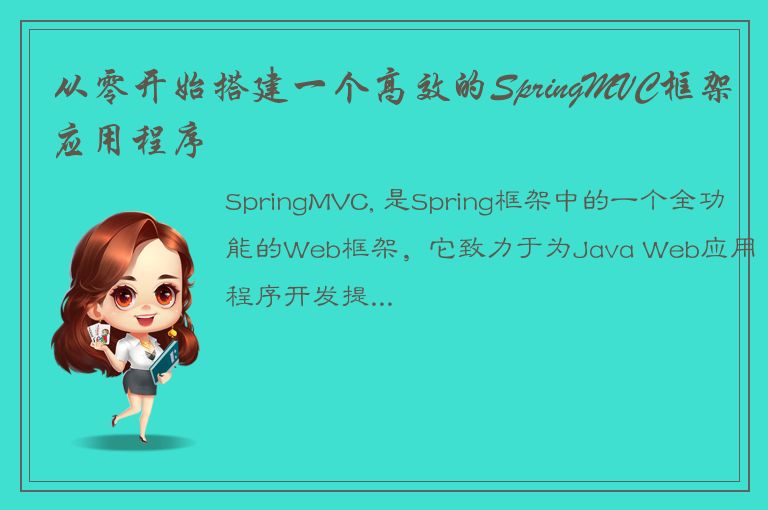SpringMVC, 是Spring框架中的一个全功能的Web框架,它致力于为Java Web应用程序开发提供一个高效而且功能齐备的解决方案。通过它,开发者可以快速地搭建出一个高效、健壮、易于拓展的Web应用程序。
本文将带领你。

第一步:搭建Web应用程序基础框架
首先,我们需要创建Maven项目,选择Spring MVC Maven Archetype快速创建一个基础框架。同时,我们需要一个IDE,本文以IntelliJ IDEA为例。
创建项目的过程中会询问是否添加Spring配置文件,选择“添加 Spring MVC 配置文件”,这样便会自动添加web.xml和spring配置文件。
web.xml文件:

springmvc-servlet.xml文件:

第二步:添加控制器
创建一个HelloController,如下:
```
@Controller
public class HelloController {
@RequestMapping("/hello")
public String hello(Model model) {
model.addAttribute("message", "Hello World!");
return "hello";
}
}
```
注解@Controller指示该类为控制器,@RequestMapping用于映射URL到该方法。 Model是用于在处理完请求后存储数据,将数据传递到jsp页面。
第三步:添加JSP页面
我们需要一个JSP页面,hello.jsp,如下:
```
<%@ page contentType="text/html;charset=UTF-8" language="java" %>
${message}
```
这个页面将从控制器中获取到的信息展示出来。
第四步:添加视图解析器
我们需要在springmvc-servlet.xml中添加视图解析器,将控制器返回的逻辑视图名解析为物理视图名。
```
xmlns:p="http://www.springframework.org/schema/p" xmlns:context="http://www.springframework.org/schema/context" xmlns:mvc="http://www.springframework.org/schema/mvc" xsi:schemaLocation=" http://www.springframework.org/schema/beans http://www.springframework.org/schema/beans/spring-beans-3.1.xsd http://www.springframework.org/schema/context http://www.springframework.org/schema/context/spring-context-3.1.xsd http://www.springframework.org/schema/mvc http://www.springframework.org/schema/mvc/spring-mvc-3.1.xsd">
```
它将逻辑视图名映射至实际的JSP视图页面路径。在本例中,视图解析器会将hello解析为/WEB-INF/views/hello.jsp。
第五步:测试
一切准备就绪,现在我们来测试一下。运行我们的项目,打开浏览器,输入 http://localhost:8080/hello ,你将看到“hello.jsp”页面中的“Hello World!”字样。
至此,我们已经完成了一个简单的SpringMVC框架应用程序的搭建。
总结
SpringMVC框架为我们提供了方便快捷、易于拓展的Java Web开发解决方案。通过了解上述基本流程,相信大家对SpringMVC有了更深刻的理解。
当然,这还只是冰山一角。SpringMVC框架在Web开发中还有众多其他高级功能,如拦截器、数据绑定、表单验证、文件上传、Restful API等等,也有许多优秀的第三方组件配套使用,如MyBatis、Hibernate、Shiro等。这些内容我们将在之后的实践中慢慢介绍。




 QQ客服专员
QQ客服专员 电话客服专员
电话客服专员